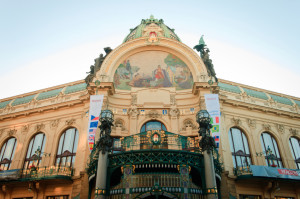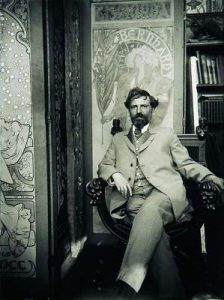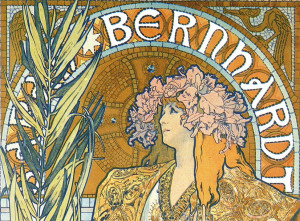Ivan Lendl: Alfons Mucha Exhibition in Prague
By Tracy A. Burns
World Premiere – Ivan Lendl: Alfons Mucha Exhibition in Prague, April – July 2013
 Visitors can view the most complete collection of the artist’s posters in the Municipal House until July 7, 2013. The unique creations belong to the extensive collection of former tennis star Ivan Lendl. There are three sections of the exhibition: the Paris Period (1894-1904), the American Period (1904-1909), and the Czech period (1909-1935). Lendl owns even more Mucha posters than any museum in the world.
Visitors can view the most complete collection of the artist’s posters in the Municipal House until July 7, 2013. The unique creations belong to the extensive collection of former tennis star Ivan Lendl. There are three sections of the exhibition: the Paris Period (1894-1904), the American Period (1904-1909), and the Czech period (1909-1935). Lendl owns even more Mucha posters than any museum in the world.
The Mucha style
The style of Art Nouveau artist Alphonse Mucha features beautiful, young women exuding optimism and happiness in extravagant, flowing robes designed in pale pastels. Flowers or crescent moons make halos around the bewitching figure’s head. Floral or botanic ornamentation also appears. Folk elements that are not only Czech but also Byzantine, Celtic, Rococo, Gothic and Judaic, among others, are characteristic, too. Arabesques plus strong, stylized outlines and naturalistic detail help capture the viewer’s admiration.
The creations of Alfons Mucha
At the end of 1894, Mucha became famous overnight when he created a new lithographed poster for Sarah Bernhardt, advertising the production of Gismonda. His style became the talk of the town. His unique poster featured a narrow, two-meter-high Sarah Bernhardt, portrayed with muted pastel colors. He also designed posters, decorative panels, calendars, book and magazine illustrations, postcards, menus, advertising signs, banknotes, stamps, and more. His cycle of the Slav Epic, 20 monumental paintings featuring the unity of the Slavs, is on display at Veletrzni Palace in Prague 7.
Mucha and the Municipal House
 When Mucha returned to Prague from a sojourn in the USA in 1910, he was commissioned to decorate the Lord Mayor’s Hall in the Municipal House (Obecni Dum), which then served as a civic and social center. He created small panels, murals, and a ceiling painting for a building that is a masterpiece of Art Nouveau architecture. Mucha’s works there feature the heroic history and national role of the Czechs. His theme of the unity of the Slavs would inspire him to design his Slav Epic creations.
When Mucha returned to Prague from a sojourn in the USA in 1910, he was commissioned to decorate the Lord Mayor’s Hall in the Municipal House (Obecni Dum), which then served as a civic and social center. He created small panels, murals, and a ceiling painting for a building that is a masterpiece of Art Nouveau architecture. Mucha’s works there feature the heroic history and national role of the Czechs. His theme of the unity of the Slavs would inspire him to design his Slav Epic creations.
The ceiling fresco in the Lord Mayor’s Hall
An eagle takes centerstage in Mucha’s ceiling fresco “Slavic Concorde.” On the eight pendentives – which are spandrels in the form of spherical triangles – human virtues are personified by prominent figures from Czech history. Faithfulness features teacher, educator, and writer Jan Amos Comenius, who promoted universal education and is considered to be the father of modern education. Justice is represented by martyr Jan Hus, who was burned at the stake in 1415 for his religious beliefs. Independence is pictured as King of Bohemia and leader of the Hussites, Jiri of Podebrady, who wanted to resolve conflicts with Catholics peacefully. Eventually, though, he was excommunicated by Pope Paul II. Eliska of the Premyslids, sometimes referred to as Elizabeth of Bohemia represents Maternal Wisdom. A princess of the legendary Premyslid dynasty, she became queen consort of Bohemia. She also was the mother of Holy Roman Emperor Charles IV, whose accomplishments on the throne greatly benefited the Czech lands. And Czech general and Hussite leader Jan Zizka stands for Militancy. Zizka is considered one of the greatest military leaders in history and is one of six commanders in history never to lose a battle. Vigilance, Strength, and Intractability are also personified. The pastel colors make the fresco lively and dynamic.
More on Mucha’s designs for the Municipal House
 Mucha drew his inspiration for the three wall frescoes from texts promoting nationalism: “Saint Mother of Nation, accept the love and enthusiasm of your sons!” was one sentence that influenced his creations. Another reads, “Humiliated and tortured you are but you shall be revived, my country!” The third resonates, “Within strength toward freedom, with love toward Concorde.” He also designed the exquisite stained glass windows in the room. Mucha’s two decorative panels above the sofas are replicas; the originals are in the Museum of the City of Prague. His designs in this space illustrate his technical expertise and ingenious creativity. They also make the room look unified.
Mucha drew his inspiration for the three wall frescoes from texts promoting nationalism: “Saint Mother of Nation, accept the love and enthusiasm of your sons!” was one sentence that influenced his creations. Another reads, “Humiliated and tortured you are but you shall be revived, my country!” The third resonates, “Within strength toward freedom, with love toward Concorde.” He also designed the exquisite stained glass windows in the room. Mucha’s two decorative panels above the sofas are replicas; the originals are in the Museum of the City of Prague. His designs in this space illustrate his technical expertise and ingenious creativity. They also make the room look unified.
Other artists who contributed to the Municipal House
The Municipal House, now housing cafes, restaurants, art exhibition spaces, and a concert hall that the Prague Royal Orchestra calls home, was designed by Osvald Polivka and Antonin Balsanek in 1905 to 1912 during a time when nationalism was at its fore. An Art Nouveau delight, it features rich ornamentation such as the mosaic “Homage to Prague” by Karel Spillar above the entranceway as well as allegorical sculpture groupings called “The Degradation of the People” and “The Resurrection of the People.” Many renowned Czech painters and sculptors contributed to its design – Mikulas Ales, Max Svabinsky, Frantisek Zenisek, Josef Vaclav Myslberk and Jan Preisler are some of the artists who decorated the building.
The Municipal House and history
Historical events have taken place there, too. The Municipal House is located on the former site of the palace of Czech kings that King Vaclav IV had built around 1380. It was the royal residence from 1383 to 1484. The proclamation of Czechoslovak independence was announced at its Smetana Hall on the birth of the democratic state, on October 18, 1918. In November of 1989, the first meeting of the Communist government with Vaclav Havel and other leaders of the democratic Civic Forum was held in this architectural gem, paving the way for the fall of Communism and the beginning of democracy.
Practical information
It is possible to take a guided tour of the interior, but times vary from day to day. A tour of the Municipal House would be a highlight of any visitor’s trip to Prague.



